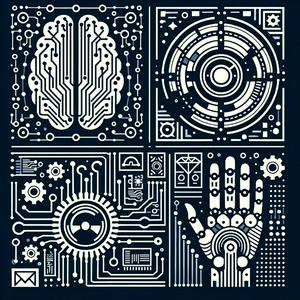Emerging Technology Trends: AI, Robotics & Digital Innovation

186 afleveringen

Robots Steal the Show: AI's Seductive Dance with Industry at CES 2025!
13-12-2025 | 2 Min.
This is you Emerging Technology Trends: AI, Robotics & Digital Innovation podcast.As we step into the future on this crisp December morning, emerging technologies in artificial intelligence, robotics, and digital innovation are accelerating at an unprecedented pace, reshaping industries from healthcare to manufacturing. At CES 2025, showcased innovations like empathetic robotics and AI-powered wearables highlighted seamless smart home integration and personalized assistance, according to Fullstack Labs reports. Hyper-intelligent robots, blending enhanced AI for natural language processing and creative problem-solving, promise breakthroughs in surgical precision and disaster response, as detailed by FirstIgnite.Cross-industry trends reveal AI merging with robotics for autonomous mobile systems in warehouses, where Amazon's latest AI-trained robots now handle millions of diverse products through vast datasets, boosting efficiency without rigid programming, per Hürriyet Daily News on October 24, 2025. Tesla's Optimus updates on October 26, 2025, advanced dexterity for factory deployment, signaling a shift toward embodied AI beyond vehicles, reports opentools.ai. The International Federation of Robotics identifies top 2025 trends: physical AI for real-world simulation training, generative AI for robotics, and energy-efficient humanoids entering new business fields.Investment patterns show promise, with AI-robotics markets eyeing 190 billion dollars by year-end, per StartUs Insights, and collaborative robots projected to claim 35 percent of sales by 2027. Quantum computing and blockchain enhance secure IoT networks, while Bain notes quantum's rising potential alongside humanoid booms. Regulatory hurdles demand ethical AI governance for transparency and safety, as Accenture emphasizes human-AI partnerships. Integration challenges like latency in edge-cloud robotics find solutions in vision-language-action models from Google DeepMind.Predictions point to profound impacts: cobots transforming logistics, exoskeletons aiding mobility, and swarm systems revolutionizing exploration, per McKinsey's outlook. Market data from Deloitte underscores Amazon's millionth robot milestone, coordinating via DeepFleet AI.Listeners, practical takeaways include upskilling in AI-robotics via platforms like ROBOTIS for embodied AI, exploring robotics-as-a-service for small businesses, and prioritizing ethical audits in deployments. These trends herald harmonious human-tech collaboration, driving growth and quality of life.Thank you for tuning in. Come back next week for more. This has been a Quiet Please production, and for me, check out Quiet Please Dot A I.For more http://www.quietplease.aiGet the best deals https://amzn.to/3ODvOtaThis content was created in partnership and with the help of Artificial Intelligence AI

Robots Unleashed: AI's Transformative Touch Sparks Industry Disruption and Ethical Dilemmas in 2025!
03-12-2025 | 3 Min.
This is you Emerging Technology Trends: AI, Robotics & Digital Innovation podcast.Artificial intelligence and robotics are converging to create unprecedented opportunities across industries in 2025, fundamentally reshaping how businesses operate and compete. The integration of advanced AI with robotic systems has evolved beyond simple automation to create intelligent machines capable of learning, adapting, and reasoning in real-time. Foundation models and large language models are transforming robots from single-purpose, linearly-programmed machines into versatile systems that understand complex instructions, spatial awareness, and physical environments.The manufacturing sector is experiencing the most dramatic transformation. Smart factories now operate autonomously with AI optimizing production lines, inventory management, and energy consumption simultaneously. Predictive maintenance systems using machine learning analyze equipment data to identify failures before they occur, dramatically reducing costly downtime. According to industry analysis, one point three billion AI-powered robots are expected to be available by twenty thirty-five, fundamentally reshaping work across warehouses, factories, and logistics networks.Collaborative robots, known as cobots, have become commonplace in manufacturing, healthcare, and agriculture. These machines combine force-limiting sensors with advanced vision systems, allowing them to work safely alongside human employees. Recent developments in vision-language-action capabilities mean robots can now interpret scenes both visually and linguistically, then act with greater autonomy. This advancement enables robots to generalize tasks across environments they were not explicitly trained on.A significant market shift is robotics as a service, or RaaS. Rather than requiring enormous capital investments, companies are offering robots on subscription models, making robotic automation accessible to small and medium-sized enterprises. Combined with edge and cloud computing strategies, this approach allows local decision-making for speed and safety while high-level coordination happens remotely.Ethical considerations are becoming non-negotiable. As robots gain more autonomy, ensuring predictable, transparent, and safe behavior aligned with human values is emerging as essential. Meanwhile, AI-powered defect detection in semiconductor manufacturing has achieved ninety-seven point six percent accuracy, demonstrating how these technologies directly impact product quality and yield.For organizations, the practical takeaway is clear: investment in AI-robotics integration is no longer optional but essential for competitive advantage. Businesses should prioritize workforce training, establish clear governance frameworks, and develop comprehensive safety protocols as these technologies expand operational capacity.Thank you for tuning in. Come back next week for more emerging technology insights. This has been a Quiet Please production. For more, check out Quiet Please dot A I.For more http://www.quietplease.aiGet the best deals https://amzn.to/3ODvOtaThis content was created in partnership and with the help of Artificial Intelligence AI

AI & Robots Steal 20 Million Jobs: Is Your Career Safe?
01-12-2025 | 3 Min.
This is you Emerging Technology Trends: AI, Robotics & Digital Innovation podcast.# Emerging Technology Trends: AI, Robotics & Digital InnovationWelcome to Quiet Please. Today we're exploring the transformative technologies reshaping our world in 2025.Artificial intelligence has moved beyond laboratories into everyday applications. The global AI and robotics market opportunity has reached 190 billion dollars, with generative AI fundamentally changing how businesses operate. Recent breakthroughs like deepfake detection technology achieving 98 percent accuracy demonstrate AI's evolving sophistication in addressing critical challenges. Tesla's October updates to its Optimus humanoid robot showcased unprecedented advances in dexterity and perception, signaling a major shift toward embodied artificial intelligence systems capable of real-world manufacturing and logistics tasks.Collaborative robots represent a particularly compelling trend. These cobots are projected to account for nearly 35 percent of all robot sales by 2027. Unlike traditional industrial robots, they work safely alongside humans, making automation accessible to small and medium enterprises. Their simplified programming and intuitive interfaces democratize robotics technology across industries.Amazon's deployment of artificial intelligence trained warehouse robots illustrates practical implementation at scale. These systems learn from vast datasets to identify, sort, and handle diverse products without individual programming for each task. This represents a fundamental shift from rigid procedural automation toward intelligent, adaptive systems.Digital twin technology creates virtual replicas of physical systems, enabling companies to test scenarios, predict failures, and optimize operations without operational disruption. This approach reduces development costs while accelerating innovation cycles across manufacturing and industrial sectors.The implications are substantial. Oxford Economics forecasts that 20 million manufacturing jobs could be displaced by 2030, making workforce transition policies increasingly urgent. However, this same technology creates opportunities. Intelligent robotics now navigate dynamic environments, adapt to product changes, and collaborate with human workers in ways previously impossible.Edge computing advances enable real-time decision making, reducing latency for critical operations. Hyperautomation combines artificial intelligence, machine learning, and robotic process automation into comprehensive strategies, streamlining end-to-end organizational operations.For organizations, the practical takeaway is clear: evaluate where artificial intelligence and robotics address your specific pain points. Start with pilot projects in well-defined processes, prioritize workforce development alongside implementation, and establish governance frameworks for responsible deployment.Looking ahead, autonomous systems will transition from experimental pilots to mainstream operations. The convergence of artificial intelligence with physical robotics will reshape manufacturing, logistics, healthcare, and service industries fundamentally.Thank you for tuning in today. Join us next week for more insights into technology and innovation. This has been a Quiet Please production. For more, check out Quiet Please dot A I.For more http://www.quietplease.aiGet the best deals https://amzn.to/3ODvOtaThis content was created in partnership and with the help of Artificial Intelligence AI

Robots Taking Over: AI's Explosive Growth Sparks Industry Frenzy!
30-11-2025 | 3 Min.
This is you Emerging Technology Trends: AI, Robotics & Digital Innovation podcast.The artificial intelligence and robotics revolution is accelerating at an unprecedented pace, reshaping industries and creating extraordinary investment opportunities. The global robotics market is experiencing remarkable expansion, valued at approximately fifty billion dollars in 2025 and projected to double to one hundred eleven billion by 2030. Meanwhile, the artificial intelligence robots sector shows even more explosive growth, anticipated to surge from six point eleven billion dollars this year to thirty three point thirty nine billion by 2030, representing a compound annual growth rate of forty point four percent.This explosive growth is driven by fundamental shifts in automation technology. Collaborative robots, or cobots, are revolutionizing manufacturing by working safely alongside human workers, with projections suggesting they will account for nearly thirty five percent of all robot sales by 2027. These systems are becoming increasingly intuitive and flexible, enabling small-batch production without requiring massive infrastructure investments. Industrial robots continue their market dominance, expected to reach one hundred sixty two point seven billion dollars by 2030, with automotive manufacturing capturing over a quarter of all deployments.The convergence of artificial intelligence with robotics is enabling machines to move beyond simple task execution to adaptive, self-improving systems. Amazon recently demonstrated this transformation when they deployed advanced artificial intelligence to train warehouse robots, allowing them to learn from vast datasets and handle millions of diverse products without direct human programming for each task. This shift from procedural automation to intelligent learning represents a fundamental reimagining of how machines operate.Across industries, digital twins are emerging as essential tools for real time monitoring and optimization. These virtual models allow companies to predict failures, test scenarios, and optimize production processes without disrupting actual operations. Edge computing is simultaneously enhancing decision making by processing data closer to its source, reducing latency in critical operations.For organizations considering robotic implementation, the immediate action items include evaluating cobot deployment for hybrid human machine workflows, exploring digital twin technologies for operational optimization, and investigating artificial intelligence training opportunities for existing equipment. The regulatory landscape remains relatively nascent, creating both opportunities and uncertainties as companies navigate ethical considerations around workforce displacement and safety protocols.The convergence of these technologies promises to reshape how we manufacture, deliver, and serve. Autonomous systems are moving from pilot projects into practical deployment across logistics, healthcare, and hospitality sectors.Thank you for tuning in today. Please join us next week for more insights into emerging technology trends. This has been a Quiet Please production. For more, check out Quiet Please dot A I.For more http://www.quietplease.aiGet the best deals https://amzn.to/3ODvOtaThis content was created in partnership and with the help of Artificial Intelligence AI

AI & Robots Sittin' in a Tree, Converging I-N-D-U-S-T-R-Y! Breakthrough Alert: 2025 Tech Revolution Ahead
29-11-2025 | 3 Min.
This is you Emerging Technology Trends: AI, Robotics & Digital Innovation podcast.Artificial intelligence and robotics are converging to create a technological revolution that's reshaping industries from manufacturing to healthcare. As we move into 2025, the integration of these technologies is accelerating faster than many predicted, driven by breakthroughs in machine learning, autonomous systems, and real-time data processing.The robotics industry is experiencing unprecedented transformation, with artificial intelligence enabling machines to move beyond programmed tasks toward genuine autonomy and adaptability. Collaborative robots, or cobots, are becoming increasingly sophisticated, featuring simplified programming interfaces that allow small and medium enterprises to adopt automation without extensive infrastructure changes. These systems are expected to demonstrate enhanced autonomy, improved safety features, and ease of use that expands accessibility across diverse sectors. By 2035, projections suggest that 1.3 billion artificial intelligence powered robots will be available, fundamentally reshaping how work happens globally.Digital twins represent another critical innovation gaining momentum. These virtual models of physical systems enable companies to predict equipment failures, optimize production processes, and test scenarios in real time without disrupting actual operations. This technology is particularly valuable in manufacturing, where companies are seeing operational savings reaching up to 26 percent through robotic automation.The broader artificial intelligence landscape shows similar momentum. Multimodal artificial intelligence systems can now simultaneously process images, text, and sensor data, enabling machines to understand context and make sophisticated decisions. Medical imaging analysis, autonomous vehicle navigation, and industrial quality control are already benefiting from these capabilities. Edge computing is accelerating real-time decision making by processing data closer to its source, reducing latency and enabling autonomous systems to operate effectively in unpredictable environments.However, significant challenges remain. Integration complexity, governance concerns, and the need for business alignment are slowing adoption in some sectors. Organizations must balance the potential for automation with workforce considerations and regulatory requirements around responsible artificial intelligence development.For listeners interested in capitalizing on these trends, the practical approach involves identifying specific operational bottlenecks where automation delivers measurable returns, beginning with pilot projects before scaling implementation. Companies should also prioritize upskilling workforces to collaborate effectively with intelligent systems rather than viewing automation as purely replacement technology.The convergence of artificial intelligence, robotics, and advanced computing technologies promises transformative efficiency gains across industries. Success requires thoughtful integration strategies that balance technological capability with organizational readiness and ethical considerations.Thank you for tuning in. Come back next week for more emerging technology insights. This has been a Quiet Please production. For more, check out Quiet Please dot AI.For more http://www.quietplease.aiGet the best deals https://amzn.to/3ODvOtaThis content was created in partnership and with the help of Artificial Intelligence AI
Meer Nieuws podcasts
Trending Nieuws -podcasts
Over Emerging Technology Trends: AI, Robotics & Digital Innovation
Luister naar Emerging Technology Trends: AI, Robotics & Digital Innovation, De Dag en vele andere podcasts van over de hele wereld met de radio.net-app

Ontvang de gratis radio.net app
- Zenders en podcasts om te bookmarken
- Streamen via Wi-Fi of Bluetooth
- Ondersteunt Carplay & Android Auto
- Veel andere app-functies
Ontvang de gratis radio.net app
- Zenders en podcasts om te bookmarken
- Streamen via Wi-Fi of Bluetooth
- Ondersteunt Carplay & Android Auto
- Veel andere app-functies


Emerging Technology Trends: AI, Robotics & Digital Innovation
download de app,
luisteren.


























